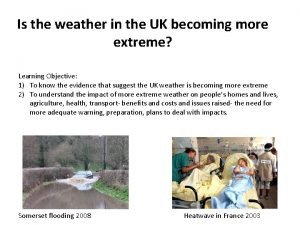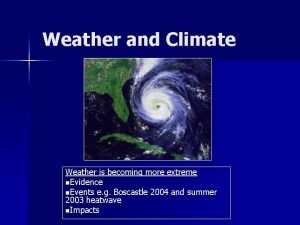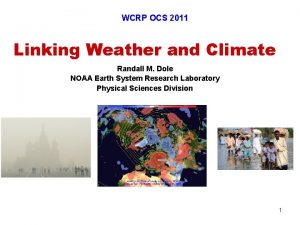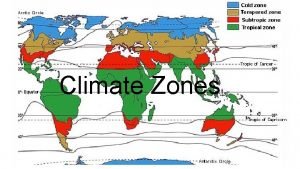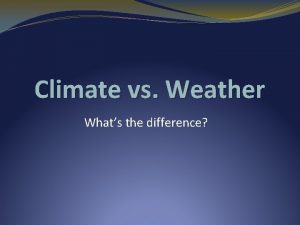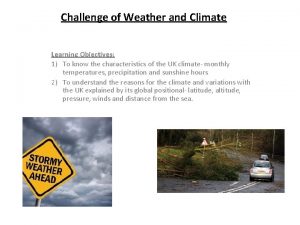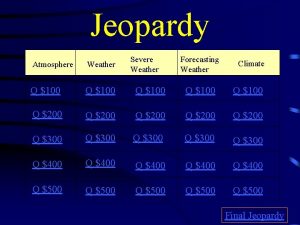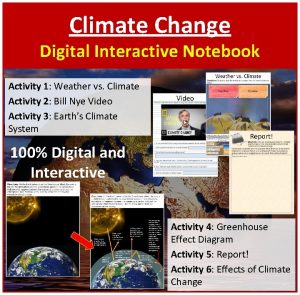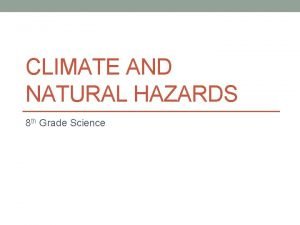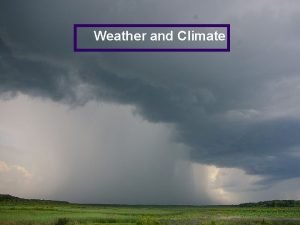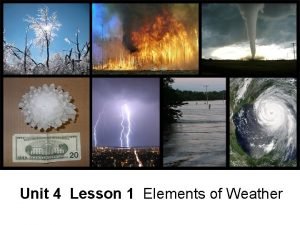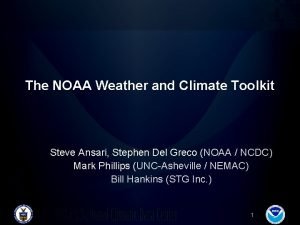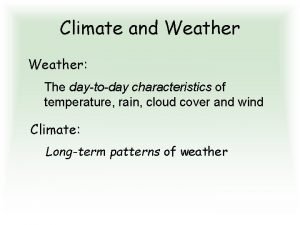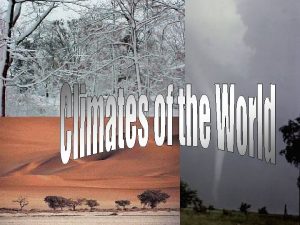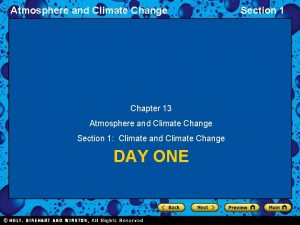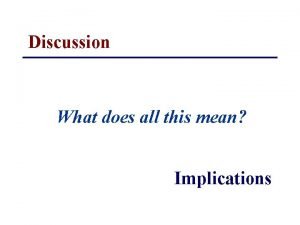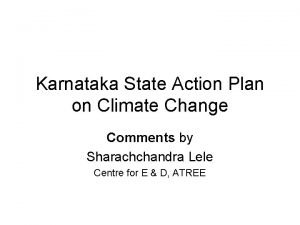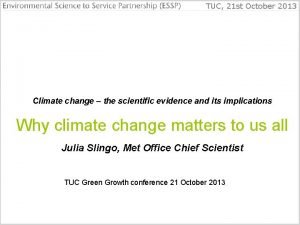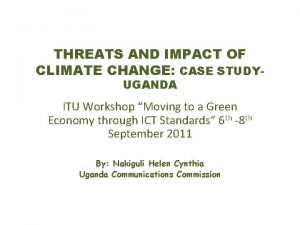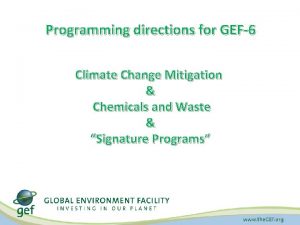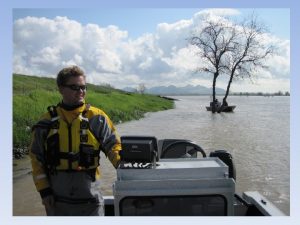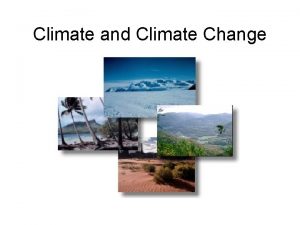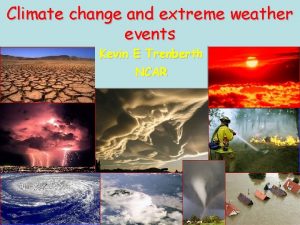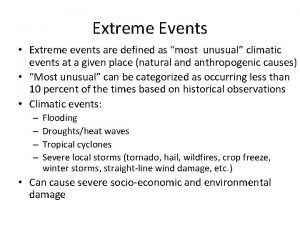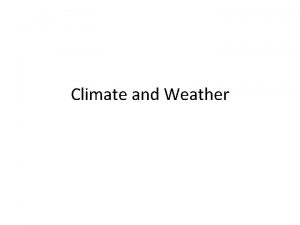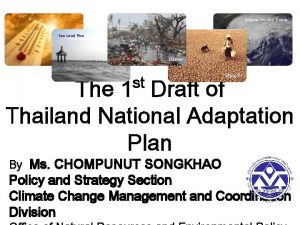Extreme Weather Events Climate Change Implications and Disaster
















































- Slides: 48

Extreme Weather Events – Climate Change Implications and Disaster Risk Management Dr. Anil K. Gupta Associate professor, National Institute of Disaster Management (Government of India, Ministry of Home Affairs) New Delhi

Catastrophe events (1970 -2001)

All natural catastrophes worldwide 1980 – 2005, number of events




Reported catastrophe losses in India, 1965 -2001

Disasters in India

Hazard Vulnerability in India 60% 8% 16%. . 15% 12%

40 million hectres are prone to flood Long coastline of 8000 kms 68% of the net area sown in the country is prone to drought More than 20% of the total geographical area of India is prone to landslides.

Major Natural Disasters : 1990 - 2006 Earthquakes Uttarkashi Latur (Killari) Jabalpur Chamoli Kutchchh, Gujarat J&K 1991 1993 1997 1999 2001 2005 Earthquake, J&K Oct. 8, 2005 Earthquake, Gujarat January 26, 2001 Cyclones East & West Godavari 1992& dist. of Andhra Pradesh 1996 Kutchchh, Gujarat 1998 Orissa 1999 Floods Punjab Kerala Punjab & Haryana Mumbai Bihar 1993 1994 1996 2005 2008 Tsunami Andaman & Nicobar Islands & coastal areas Tsunami Dec. 26, 2004 11

Increased Mortality and Homelessness Year Disaster Events Deaths Houses Destroyed / damaged 1993 Latur Earthquake 8, 000 200, 000 1999 Orissa Super Cyclone 10, 000 275, 000 2001 Bhuj Earthquake 13, 800 1, 000 2004 South India Tsunami 16, 500 150, 000 2005 Jammu & Kashmir Earthquake 1, 300 41, 000 2008 Kosi Floods, Bihar 300 375, 000 2009 Cyclone, AILA 120 so Affected 5. 4 million people in 18 districts far

Global analysis of records reveal that nearly 90 % of loss of life due to natural disasters were caused by weather- climate and water-related hazards Increasing number of natural disasters over the past five and half decades (Data from UN/ISDR – “Disaster Statistics” http: //www. unisdr. org/disaster-statistics/occourence-trends-century. htm)

CLIMATE-CHANGE AND DISASTER RISKS Geo-physical • Ocean temperature • Sea level • Snow cover • Mountain glaciers • Arctic sea-ice extent • Permafrost extent • GLOFS Climatic • Wind patterns • Air temperature • Precipitation patterns • Rainy days • Rainfall • Spatial distribution • Evaporation • Transpiration Disaster • Floods • Heat waves • Tropical cyclones • Cold days and nights • Hot extremes • Droughts • Desertification

Environment, climate and disasters

DISASTERS IDENTIFIED BY High Powered Committee (HPC) I. WATER AND CLIMATE RELATED DISASTERS 1. Floods 2. Cyclones 3. Tornadoes 4. Hailstorm 5. Cloud Burst 6. Heat Wave and Cold Wave 7. Snow Avalanches 8. Droughts 9. Sea Erosion 10. Thunder and Lightning 11. Tsunami (Added)

II. GEOLOGICALLY RELATED DISASTERS 1. 2. 3. 4. Landslides and Mudflows Earthquakes Dam Failures/ Dam Bursts Mine Fires III. CHEMICAL, INDUSTRIAL AND NUCLEAR 1. Chemical and Industrial Disasters 2. Nuclear Disasters

IV. ACCIDENT RELATED DISASTERS 1. Forest Fires 2. Urban Fires 3. Mine Flooding 4. Oil Spill 5. Major Building Collapse 6. Serial Bomb Blasts 7. Festival related disasters 8. Electrical Disasters and Fires 9. Air, Road and Rail Accidents 10. Boat Capsizing 11. Village Fire

V. BIOLOGICALLY RELATED DISASTERS 1. 2. 3. 4. Biological Disasters and Epidemics Pest Attacks Cattle Epidemics Food Poisoning

Disaster - types: Naturally-classified… ¡ Environmental (natural or man-made) l l l ¡ ¡ Rail, Industrial (Electrical, Mechanical, chemical. . ), Nuclear, Aviation, Road… Security threats l ¡ Originating in environment Technological & civil / sectorial l ¡ Geo-hydrological Biological Chemical Fires (env. ) Epidemics…. Terrorism, sabotage, bomb blast… War Festival related – Stempede etc.



ALARP ¡ As Low As Reasonable Practicable (ALRAP) DRR ZONE BATNEEC


Disaster Risk Management Disaster Management Vehicle RISK MANAGEMENT Prevention EMERGENCY RESPONSE Mitigation Planning Preparedness Planning Response Hazard / Risk Reduction Vulnerability Reduction ENVIRONMENT Emergency Risk Assessment Governance COMMAND community Evaluation Monitorin g Management centric Reconstruction Rehabilitatio n Operation centric Relief

FUNCTIONS-…. DISASTER REDUCTION HAZARD RISK ANALYSIS MULT-HAZARD IMPACT ANALYSIS SITE RISK ASSESSMENT DISASTER MANAGEMENT STRATEGY RISK INTEG RATION INTO DEVELOPMENT EMERGENCY RESPONSE & EVALUATION LAND-USE & ENVIRONMENTAL SETTING MCAS & CONSEQUENCE ASSESSMENT HAZARD MITIGATION EMERGENCY PLANNING PREPAREDNESS RESPONSE DRILL

IMPACTS OF DISASTERS Disaster Event Physical Environmental SOCIAL Economic ¡ ¡ Physical (buildings, structures, physical property, industry, roads, bridges, etc. ) Environmental (water, land/soil, land-use, landscape, crops, lake/rivers / estuaries, aquaculture, forests, animals/livestock, wildlife, atmosphere, energy, etc. ) Social (life, health, employment, relations, security, peace, etc. ) Economic (assets, deposits, reserves, income, commerce, production, guarantee/insurance, etc. )

DM Paradigm Shift ¡ ¡ Response Centric Relief Centric l l l Mitigation centric Preparedness centric Disaster Centric Adaptation ¡ ¡ ¡ Hazard Centric Vulnerability Centric Environment Centric

PREVENTIVE DISASTER MANAGEMENT A. Hazard – Vulnerability Relief Disaster B. Hazard - Disaster Mitigation A: Business as Usual; B; Preferred Approach Relief

Concept of Disaster Risk Reduction: ¡ Event minimization ¡ Loss minimization ¡ Quick recovery (Resilience) Approach: ¡ Visualizing hazards ¡ Reducing vulnerability ¡ Increasing coping capacities

DRR Strategy Design – Components ¡ What is the risk hazard - event ¡ What l ¡ ¡ l l ¡ is at risk – Life, Structures, Resources, Infrastructure Resist Resilience l Avoid Tolerate Manage Programmes l l l x damageability Direct Indirect Infused

HRVC Analysis ¡ Hazard identification l l ¡ Critical Facility Analysis l l l ¡ Establish relative priorities for your hazards. Hazard Mapping Identify critical facilities categories Complete a critical facilities inventory Identify intersections of critical facilities with highrisk areas Vulnerability Analysis l l Societal Infrastructure Environmental Economic

Disaster Risk Management and Adaptation Strategies ‘adaptation’ to climate-change and its implications towards disaster management, aims at developing a set of abilities to sustain in the given complex scenario of influences along human environment. THE COMPONENTS OF ADAPTATION Reducing the risk of occurrence of a hazard event (i) prevention (ii) mitigation or (iii) control Sensitivity-adaptation framework to climate-change Reducing exposure to hazardous event (i) avoidance/migration (ii) resilience Capacity to contain (i) prevent damages (ii) prevent losses (iii) early normalcy

Potential hazards, DRR-Adaptation and mainstreaming options

View point: outside a political manual or drought declaration DROUGHT SEQUENCE Meteorological Hydrological Environmental Ecosystems Agriculture Socio-economic Drought Habitation

The Disaster Management Act 2005 ¡ The Disaster Management Act was enacted on 23 rd December, 2005. The Act provides for establishment of l l l ¡ ¡ NDMA (National Disaster Management Authority) SDMA (State Disaster Management Authority) DDMA (District Disaster Management Authority) Act provides for constitution of Disaster Response Fund and Disaster Mitigation Fund at National, State and District level. Establishment of NIDM and NDRF.

NATIONAL INSTITUTE OF DISASTER MANAGEMENT ¡ ¡ Ministry of Agriculture set up National Centre for Disaster Management at IIPA in 1995 NCDM scaled up to NIDM in October 2003 (as part of Ministry of Home Affairs, Govt. of India) NIDM is a Statutory Body (Chapter 7 - DM Act, 2005) 4 Academic divisions and 4 multi-disciplinary research cells

STATUTORY MANDATES ¡ Develop Training Modules, Undertake research & documentation, Organize training programmes; ¡ Formulate and implement a comprehensive Human Resource Development Plan covering all aspects of disaster management; for all the sectors, ¡ Provide inputs in National Level Policy formulation; ¡ Guidance to training and research Institutes for development of training & research programmes

MANDATES……. n n Training of faculty members of Disaster Management /State training institutes Develop educational materials for disaster management including academic & professional courses; Promote awareness among stakeholders including college or school teachers; technical personnel & others associated with multi-hazard mitigation, preparedness and response Promotion of disaster management education at higher/university, college, school level

KEY ACTIVITIES in the context of Networking ¡ ¡ ¡ Joining Efforts with support of ATIs Sharing Experience through Conference, Workshops, Policy dialogues Documenting events, e. g. Orissa Cyclone, Gujarat EQ, Kumbakonam Fire, Meerut Fire, Barmer Flood, Mumbai Floods etc Editing Contents through knowledge Institutions (IDKN Model) E-Learning e. g. VLE, Moodle Platform WBI Courses E-Shishak will be launched soon.

ACHIEVEMENTS ¡ ¡ ¡ ¡ ¡ >400 training programmes & trained (both trainers & line stakeholders) South Asia Policy Dialogue in August 2006 First India Disaster Management Congress in Nov. 2006 International Workshop “Risk to Resilience –Strategic Tools for DRR” Central Sector Scheme; 30 “Disaster Management Centres” in different States in India Incident Command System and MEPP Trainings including NDRF, Civil Defense, Paramilitary, etc. Partnership with >50 international and national institutions/agencies On-line Training Programmes with World Bank Institute, Washington. National Programmes for Capacity Building of Engineers and Architects Second India Disaster Management Congress in Nov. 46. 2009 )(800 delegates including 100 international)


Related Policies ¡ ¡ Disaster Management Policy (Draft) Environmental Policy l ¡ ¡ ¡ Planning Commission Working Plan 2009 -12 Environment & Forests Land-use Policies Agriculture Policy Water Policy Voluntary Sector Policy WRD & Hydro-Power policy Rural Development (land resources) Housing Policy Forest Policy Statement of Climate Change Right to Information Map Policy

Programmes (examples) § § § § Disaster Risk Management Programme National Emergency Communication Plan Disaster Management Decision Support Programme Natural Resources Data Management System NRDMS Environmental Information System APELL JNURM Integrated Coastal Zone Management National River Conservation National Wetland Programme National Wasteland Programme Rural employment Mid-day meal scheme Microfinance

Strategic Tools that help and/or implement policies ¡ ¡ ¡ ¡ ¡ Project Appraisal Process Policy Appraisal – SEA (of policy, plan, programmes) EIA / REIA – DMP & EPP? DRA as part of Project Appraisal process Carrying capacity based planning Risk based developmental planning Cost-Benefit Analysis Economic cost of impacts Risk Auditing Integration of Strategic Tools

Integrated Environmental Management as Sustainable Solution to Disaster Risk Challenges


THANK YOU envirosafe 2007@gmail. com
 Climate change 2014 mitigation of climate change
Climate change 2014 mitigation of climate change Ecu shot type
Ecu shot type Extreme climate
Extreme climate Why is uk weather becoming more extreme
Why is uk weather becoming more extreme Weather in boscastle
Weather in boscastle World geography today
World geography today Weather climate and society
Weather climate and society What is this
What is this Weather and climate similarities
Weather and climate similarities Conclusion of weather and climate
Conclusion of weather and climate 12 climate zones map
12 climate zones map Whats the difference between weather and climate
Whats the difference between weather and climate Objectives of weather and climate
Objectives of weather and climate Weather and climate crash course
Weather and climate crash course Temperate climate zone plants
Temperate climate zone plants Weather and climate brainpop
Weather and climate brainpop Weather and climate jeopardy
Weather and climate jeopardy Weather and climate interactive activities
Weather and climate interactive activities Tools used to measure weather
Tools used to measure weather Rains proff
Rains proff Poem fashion
Poem fashion Noaa weather and climate toolkit
Noaa weather and climate toolkit Explain how some hail can become baseball sized
Explain how some hail can become baseball sized L
L Kahoot.com
Kahoot.com Weather. lesson 1
Weather. lesson 1 Noaa weather and climate toolkit
Noaa weather and climate toolkit What happens when the temperature of the air cools brainpop
What happens when the temperature of the air cools brainpop Contingent crop planning slideshare
Contingent crop planning slideshare Reflection and refraction venn diagram
Reflection and refraction venn diagram Noaa weather and climate toolkit
Noaa weather and climate toolkit What is the red line on a climate graph
What is the red line on a climate graph Disaster scenario media and information literacy
Disaster scenario media and information literacy Mutually exclusive events vs not mutually exclusive events
Mutually exclusive events vs not mutually exclusive events Factors affecting climate
Factors affecting climate Climate change meaning
Climate change meaning Atmosphere
Atmosphere Chapter 13 atmosphere and climate change
Chapter 13 atmosphere and climate change Discussion and implications
Discussion and implications Persuasive essay about global warming
Persuasive essay about global warming Karnataka state action plan on climate change
Karnataka state action plan on climate change Climate change brainpop
Climate change brainpop Unit 9 climate change
Unit 9 climate change Conclusion of climate change
Conclusion of climate change Youreuropemap.com
Youreuropemap.com Conclusion of climate change
Conclusion of climate change Mathematics of climate change
Mathematics of climate change Globalization definition ap world history
Globalization definition ap world history Climate change mitigation
Climate change mitigation



